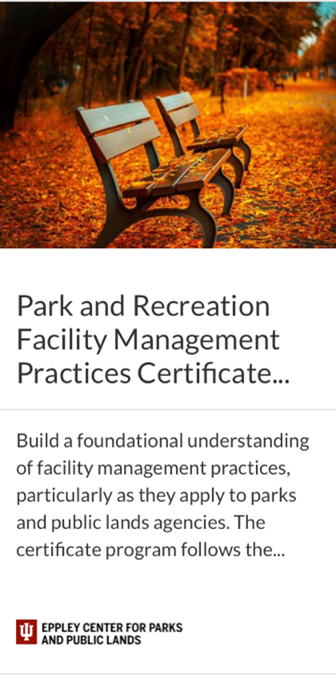Competency Check: Facility Asset Management is a foundational competency for parks, recreation, and public lands organizations.

Stewarding the lands, infrastructure, buildings, and outdoor recreation facilities on public lands is, in many cases, why the agency exists. Everyone almost always agrees that the management of these ‘assets’ for the long-term viability and public use is a central mission of almost all park, recreation, and public lands management organizations. Yet, defining that core function of the organization is not always well understood. Based on Eppley’s decades of work in facility asset management for parks, recreation, and public lands, the basics of this core function are described below.
Defining and training facility asset managers for park agencies is challenging as often the core competencies of the individuals employed as park superintendents, facility managers, park operations managers and in similar positions may not have any professional preparation in facility asset management. Defining an agency and its leaders need to know about facility asset management is based on answering the following questions about the agency’s portfolio of lands, facilities, trails, infrastructure, and features.
1. What assets does the agency own, and where are they?
An asset in the profession of facility management and park agencies is not cash or financial investments. It is infrastructure, capital investments, land, and the facilities and equipment on that land used for park and recreation purposes. Can the agency and its leaders easily provide:
- The number, size, age, and location of the assets in the agency’s portfolio
Many agencies cannot provide this information precisely or easily. It can be a daunting task to start from nothing and some agencies do not believe it is their responsibility as similar tasks are often managed finance, public works, engineering, and other agencies. Effective facility asset management for a park, recreation, and public lands management organization starts with knowing what you own, manage, and age.
2. What is the Current Replacement Value (CRV) of the asset portfolio?
In other words what are the parks, trails, features, facilities, and equipment in the parks worth? One way to think of this is if a natural disaster wiped out most of the park agency’s facilities, how much would it cost to replace it?
- Identifying the assets, defining size, and age is essential to calculate the value of each asset generally
It is impressive to policy makers, advisory boards, and the citizenry when an agency can state they manage xx number of assets with $xxx total replacement value. Understanding that value and it is an approximation (many CRV estimates are plus/minus 30% and that is often explained in discussing CRV) provides a basis for everyone to understand how important the matters before them are. Many park agencies manage a vast portfolio of assets for the citizens and stakeholders of the organization, and likely do not know its overall dollar value.
3. What is the current condition of the asset portfolio?
This adds more complexity to the agencies’ knowledge and understanding, and appreciation too, of the work they do in stewarding facility assets. Again, this involves inspecting assets and understanding that the information gathering process approximates condition based on the inspections. Thorough inspections are important but not during this effort to understand the condition of the asset portfolio.
- Understanding asset condition, age, replacement date, and deferred maintenance (DM), as well as critical safety issues is part of this activity
In the profession of facility management, the estimates of the CRV, DM and other numbers are, by design, used to create metrics that measure the overall condition of the portfolio and provide relative priorities for assets that need more attention. Again, approximate cost estimates are used, often based on square-foot costs of similar construction with a range of -30 percent to +50 percent accuracy. The intent is to provide a reasonable and standard metric for managing the assets in the portfolio and help prioritize maintenance in the portfolio.
4. What is required to maintain all the assets in the portfolio (i.e., annual operating and maintenance costs to keep the assets in good order) and address deferred maintenance over time?
This last fundamental question is the most complex and estimates the staff and funding needed annually to maintain and operate the entire system of facilities, parks, trails, sports fields, playground equipment, etc. in a reasonable condition.
- The estimates are then compared to budgeted expenditures to see if a ‘gap’ exists between what funding is needed and what funding is available
This estimate allows policy makers to know what the performance target funding should be for the park, facility, trail, and other assets should be, and if there are shortfalls or gaps in funding, prioritize the stewardship dollars being spent. It helps to document the overall condition of the publicly owned system, seek additional funding, and/or perhaps reduce the number of high maintenance assets if not a priority.
Summary:
A good rule of thumb; can your agency leadership answer the questions above in brief summary answers if asked by the public or a policy maker. Agencies who decide to implement an asset management approach will see the benefits in citizens and policy makers improved understanding that the park and recreation system needs to be invested in regularly and at the appropriate levels. Often this leads to additional funding for facility and asset management.

Learning More:
Eppley has facilitated successful facility asset management plans with the National Park Service, Boulder, Anchorage, and other agencies that resulted in improved capacity for facility asset management, and eventually additional funding for the agency. We have taken that information and created an online micro-credential training in Park and Recreation Facility Management Practices at https://expand.iu.edu/browse/iidc/eppley/courses/park-and-recreation-facility-management-practices-certificate-program
Learners will take 5 online courses and submit assignments to gain the competencies of facility asset management for their agency. A 20% discount on the certificate program is available through May 31, 2024, using the promotional code FMP2024.